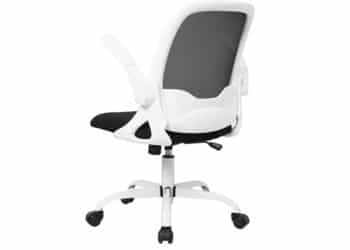A good revolving chair is a staple part of the modern office. The chair we use in the office is considered an ergonomic feature because having an adjustable height. Most people like to purchase pneumatic height adjustment chairs to improve their relaxation level.
Most of our time in the office spend sitting in an office chair, so we ensure that we remain comfortable throughout the day. A bad posture can add stress to the structures in the spine on pulling eight- or nine-hour days at a desk in that position.
A chair must be comfortable and ergonomic, supporting the lower back and allowing the good posture to work long on the desk. The pneumatict chair provides optimum balance for the lower back, adequate blood circulation to the feet, and eliminates pressure points behind the knees.
- What is Ergonomics?
- Pneumatic Or Ergonomic Chairs:
- What Does The Term Pneumatic Mean?
- How Does A Pneumatic System Work In Office Chairs?
- What Does The Pneumatic Gas Cylinder Mean?
- Pneumatic Cylinder Working Principle:
- Components of a Gas Cylinder:
- What’s The Stroke Of A Pneumatic Chair?
- Do You Want To Determine The Stroke Of Your Chair?
- Weight Capacity Affects The Pneumatic Chairs:
- Conclusion:
What is Ergonomics?

We use the word Ergonomics. Do you know what it means?
Ergonomics has a vast meaning; it combines psychology, anatomy, physiology, and engineering. Ergonomics is part of our lives, how we interact with the environment, and how the setting can be changed to ensure healthy working practices.
Pneumatic Or Ergonomic Chairs:
Many ergonomic chairs are designed to support posture while spending a lot of time sitting in an office chair.
This kind of chair has many features to improve posture and comfort. These chairs are equipped with mechanisms to help to adjust the seating positions quickly and easily called the pneumatic seat height adjustment hydraulics via a lever below the chair.
What Does The Term Pneumatic Mean?

Pneumatics is used for easily compressible gas such as air to enable machinery movement. Have you ever wondered if your office chair pops up on pushing the height adjustment lever?
It’s all about compressed air, which plays a role in all pneumatics work. Adjusting chair height to move the seat up and down also involves the exact compressed air phenomenon.
How Does A Pneumatic System Work In Office Chairs?
Many components are involved in designing a pneumatic chair that adjusts the chair’s height. They are generally adjusted by using a lever situated just below the seat. Now the question arises, how does it work?
Here is the list of the main component of a pneumatic chair:
- The base of the chair
- A pneumatic gas cylinder
- A padded seat that was covered with a plate holding the lever
- A comfortable and ergonomic back support
What Does The Pneumatic Gas Cylinder Mean?
The central part of the pneumatic chair is the gas lift or the pneumatic cylinder, which allows and facilitates raising or lowering down your office chair. The pneumatic gas cylinder is a new invention that uses compressed air to change the height rather than the old technology of threaded spindle lift.
You have to turn your chair clockwise and anti-clockwise to raise or lower the chair height in the old technology. With the innovative pneumatic gas cylinder, you can easily find a comfortable and ergonomic sitting position.
Pneumatic Cylinder Working Principle:
Compressed air is the critical thing that plays a vital role in pneumatic cylinder working. While putting your weight on the seat, simple things you have to do are activate the cylinder by engaging with the lever behind the seat.
It will push out the piston, and the air in the chamber is expanded, which allows the seat to be lowered. Releasing your weight from the middle of your chair-activated cylinder will push the piston out of the air chamber, raising your seat height.
Components of a Gas Cylinder:
A pneumatic chair gas cylinder consists of the following parts:
- Outer column or a Standpipe: It is a column or a pipe of almost 2 inches diameter trapped from the bottom. The trapped end connects to the chair’s wheelbase while assembling an office chair. The diameter of the column is standard, but the height may differ from model to model to make it an ergonomic chair.
- Inner column or a piston: A pneumatic chair is built around an acting cylinder and a piston. The outer column or chamber is connected to a piston of 1.1 inches in diameter. The piston’s lower end is tapered to adjust in the hole on the seat base, also called the swivel unit.
- The piston activates by pushing the lever attached to the bottom and raising or lowering it to adjust the chair height.
- Lever or Actuator: It’s just a control button or the lever placed on the top of the piston and lower side of the chair’s seat, which activates the cylinder. You can quickly raise or lower the chair to adjust the required height.
- Dust Cover: On the top of the column, a protector is placed to cover the whole assembly from dust.
- Retainer Clip: A clip is attached to the piston column, which plays a significant role in keeping the cylinder sliding out and creating an emergency.
What’s The Stroke Of A Pneumatic Chair?
The term stroke or travel is prevalent and is mentioned on the pneumatic chair’s specs. But most of us never spend time reading the spec sheet.
Stroke in terms of a pneumatic chair is the ability of the cylinder how much it will raise or lower the chair within a certain number of inches.
For example, if your chair has a 4-stroke cylinder, you have the range to uplift or lower the chair up to 4 inches.
Do You Want To Determine The Stroke Of Your Chair?
A simple and easy way to determine the stroke of your current chair is as.
- Engage the lever, raise your chair to its highest point, and measure the seat’s height from the floor.
- Please do the same measurement procedure by lowering the height of the seat of your chair to its lower level.
- The stroke or travel will be the difference in the heights of the lower and upper points.
The stroke of a chair may vary from chair to chair. It depends on your height, the height of the chair, and the height of your table. The stroke range number varies from 3 inches to 10 inches.
Weight Capacity Affects The Pneumatic Chairs:
The weight plays a vital role in working the pneumatic chair’s gas cylinder. The standard pneumatic chairs come with the maximum weight capacity. The standard cylinder of an ergonomic task chair might be closer to 250 lbs. On the other hand, big and tall class 4 pneumatic chairs can handle over 450 lbs.
Conclusion:
Pneumatic chairs are the blessing of today’s life to work longer hours without tiredness. If your chair won’t work correctly, it’s all because of your faulty gas cylinder.
So either send it back to the manufacturer or fix it yourself. In that case, go online and find the required stroke cylinder and insert it back into your wheelbase and seat. This part should be pretty easy for you after going through the whole article.

I’m Justin Allen, found of mychairreviews.com where I review gaming chairs, massage chairs, recliners for people who are looking to buy one. I love writing things on the internet and blogging about anything that interests me which is usually video games, technology, or sports-related items. When I am not working on blog posts or reviewing products I have a passion for you can find me playing video games with friends online!



